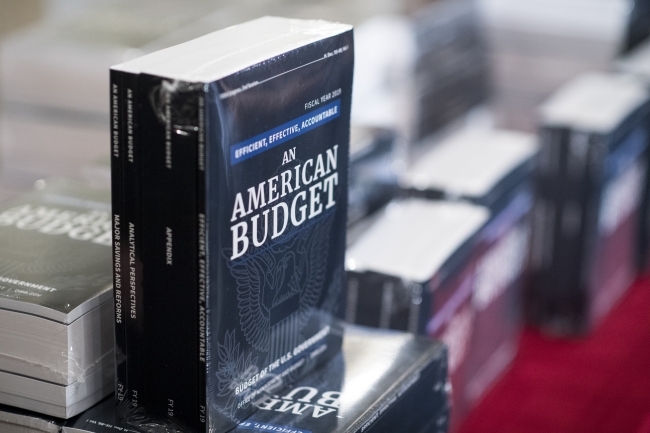You have /5 articles left.
Sign up for a free account or log in.

Getty Images
The White House budget released Monday won't be approved by Congress and likely won't even be seriously considered by lawmakers as a framework for their spending priorities. But the document makes clear that the Trump administration is in many respects on the same page with House Republicans as they seek to dramatically reshape the student aid system in renewing the Higher Education Act.
President Trump's budget proposes consolidating multiple income-contingent repayment plans for student borrowers into a single plan, eliminating Public Service Loan Forgiveness, and ending subsidized student loans. It also would expand Pell Grant eligibility to short-term nondegree programs, end the Supplemental Educational Opportunity Grant and overhaul the Federal Work-Study program.
Although there are some significant differences over details, those are all changes sought by the PROSPER Act, the Higher Education Act reauthorization bill approved by the Republican-led House's education committee in December. The budget document even endorses a risk-sharing measure to put colleges on the hook for student outcomes, another feature of the House HEA plan. (One significant difference in the Trump budget: it seeks, for the second year in a row, to cut the total work-study budget in half.)
Higher ed and student advocate groups have criticized PROSPER as overly partisan legislation that would make college less accessible. They offered much the same take on the White House proposal Monday.
Over all, the proposal would seek to cut the Department of Education's budget by $3.6 billion, or 5 percent, from 2017 levels, although direct student aid spending would be held steady.
Meanwhile, the White House proposed keeping funding flat for key federal research agencies. And it sought to eliminate agencies and programs including AmeriCorps, the National Endowment for the Arts and the National Endowment for the Humanities.
Simplifying Student Aid
Department officials said streamlining repayment options for student loans would create an easier-to-navigate system for student borrowers. And they said expanding Pell eligibility to short-term programs would help individuals who are out of work quickly learn new skills to secure employment, although critics have questioned how the department will ensure those funds go only to high-quality programs.
“The president’s budget request expands education freedom for America’s families while protecting our nation’s most vulnerable students,” Education Secretary Betsy DeVos said in a statement. “The budget also reflects our commitment to spending taxpayer dollars wisely and efficiently by consolidating and eliminating duplicative and ineffective federal programs that are better handled at the state or local level. I look forward to working with Congress to pass a budget that puts students first and returns power in education to where it belongs: with states, districts and families.”
While the president's budget is received as little more than a recommendation by Congress, this proposal may have even less influence on lawmakers than one in a typical year. After two separate government shutdowns this year -- including one lasting just hours -- Congress last week approved a new spending deal and a two-year budget agreement.
Critically for many higher ed institutions, that budget deal permanently lifted caps on new spending at federal agencies put in place by Congress in 2011. The White House budget proposal was in the works long before the budget deal was passed. But when those caps were lifted, the administration scrambled to make new calculations so it could issue a budget addendum Monday. That document proposed adding an additional $300 million to the Federal Work-Study program and restoring $1.6 billion cut from the Pell Grant surplus in the original budget proposal.
Robert Kelchen, an assistant professor of higher education at Seton Hall University and an expert on student aid policy, said there wasn't much new to be found in the proposal.
"It's basically more of the same," he said. "I don't think Congress is going to be making policy based on this budget."
Mary Sue Coleman, the president of the Association of American Universities, said in a statement that the White House proposal would make higher education less affordable and less accessible at a time when the economy demands a highly skilled and highly educated work force. The budget, she said, would also "cripple our nation’s position as a global science and technology leader and greatly erode the longstanding government-university partnership that supports our public health, national defense, and economic competitiveness."
Former education secretary John B. King Jr., now president and CEO of the Education Trust, said in a statement that the proposal "continues a relentless assault on the American Dream," by seeking to dismantle programs for the most underserved.
"Through this budget proposal, the administration has revealed that their priorities have not changed -- priorities that actively dismantle the nation’s safety net; reverse progress for students of color, low-income students and their families; and jeopardize the nation’s future prosperity," he said. “I hope that Congress will reject this proposal and continue on its current path toward funding the government at levels that expand opportunity for more Americans.”
As in its fiscal year 2018 budget proposal, the White House was set to seek big cuts to the government's biggest research agencies, the National Institutes of Health and the National Science Foundation. But after Congress lifted the spending caps, the administration proposed holding the funding of both agencies roughly equal to 2017 levels. That's still significantly less than Congress approved for the NIH in its budget deal last week, which awarded $2 billion in additional funding to the agency for 2018 (how NSF will fare under the deal is unclear).
And the budget proposal renews calls from the administration to eliminate entities including AmeriCorps, the National Endowment for the Humanities and the National Endowment for the Arts.
Senate appropriators last year introduced a spending bill that would keep funding at the NEH and NEA equal with 2017 levels.




